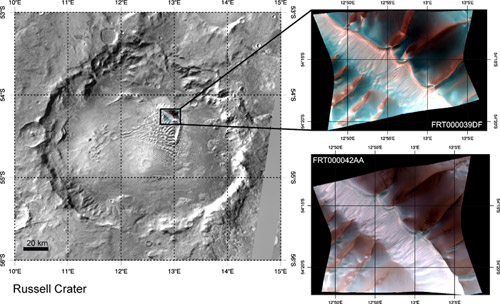|
|
 |
| Press Release Images |
 |
| Return to Press Release Images index |

|
|
Full Res JPG (1.52 MB)
|
Mars Reconnaissance Orbiter is an overachiever! About six months into its science-gathering phase and the orbiter has already returned 11 Terabits of data - that's enough to fill over 2,000 CDs! The total goal for the mission lifetime is 34 Terabits. Among the impressive data are images from the orbiter's Compact Reconnaissance Imaging Spectrometer for Mars (CRISM) instrument. With CRISM, the science team intends to investigate the entire red planet in spectral mode at a resolution of 200 meters (656 feet) per pixel. The instrument has already logged data for 50 percent of the planet!
"CRISM has revealed sites with very interesting mineralogy that we want to investigate more closely," said Deputy Project Scientist Sue Smrekar. "Images from these sites are helping us learn more about Mars' ancient climate and the role of water on the surface."
The identification of scientifically interesting sites is also vital to future landed missions. Remember, Mars Reconnaissance Orbiter is on the lookout for prime landing sites for the 2009 Mars Science Laboratory.
|
JPL Image Use Policy
|